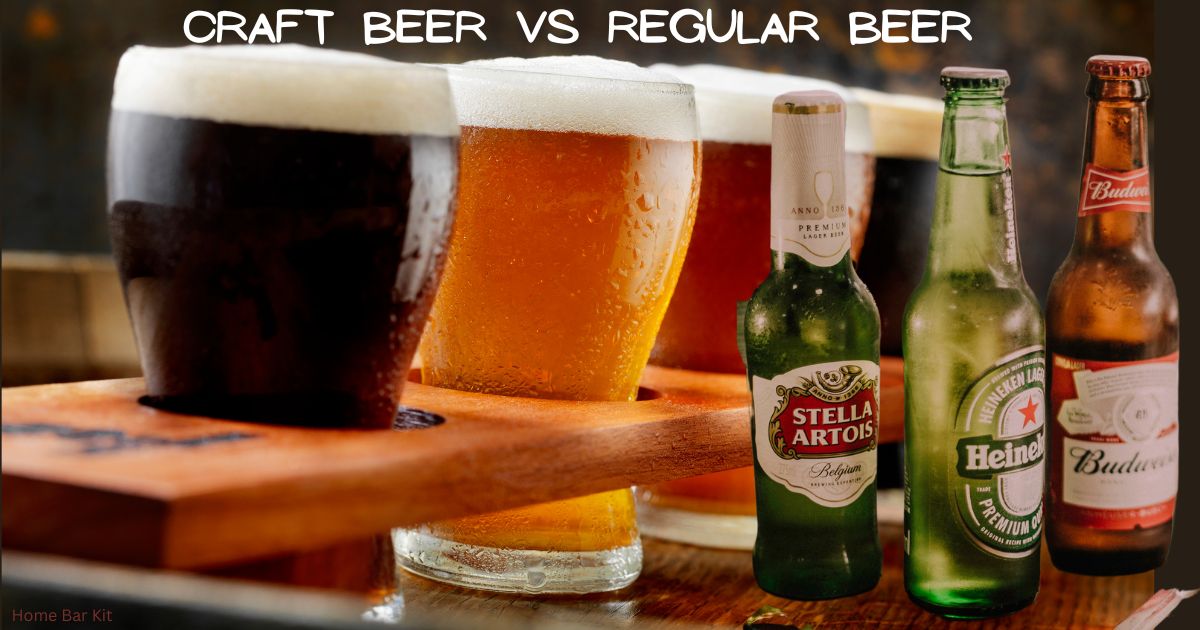There are many beer lovers in the world, some of which have embraced craft beer. While others have not strayed from regular beer, and don’t intend to. Do small independent breweries produce better beer than the large multi national breweries? And does this make craft beer better than regular beer?
Declaring one type of beer better than another is somewhat subjective. However the debate as to whether craft beer is better than regular beer is subjective. It comes down to personal taste and the relationship with what’s in your glass.
Table Of Contents
Craft Beer Vs Regular Beer
Beer has been a staple in human culture for thousands of years. Fast forward to today and we find a modern twist in this ancient tale; the rise of craft beer.
This isn’t just about a trendy beverage; it’s also about a movement. Craft beer’s popularity has skyrocketed, giving traditional beers a run for their money. This includes household names and multinational breweries that produce what we call ‘regular beer.’
Before we get into the hoppy details, it’s important to clarify what sets craft beer apart from regular beer.
Craft beer is typically produced by smaller, independent breweries dedicated to flavour, quality, and technique.
On the other hand, regular beer is often the output of larger, more established breweries focused on mass production and widespread distribution.
Can one be better than the other?
Is Craft Beer Better Than Regular Beer?

To say craft beer is better than regular beer is based on personal opinion, it is subjective. The same goes for declaring regular beer as better than craft beer.
However, many beer enthusiasts tend to lean towards craft brews. This conversation isn’t just about taste; it’s also about culture, community, and a personal relationship with what’s in your glass.
If you’re the adventurous type, craft beer might be your best friend. Craft breweries often push the boundaries, experimenting with various ingredients, brewing methods, and styles.
That means a wide array of flavours and experiences beyond what regular beer typically offers. It’s like comparing a home-cooked meal to fast food; both can satisfy, but one holds a unique, personal touch.
But surely we have to acknowledge the reliability of regular beer. It’s widely available, consistent, and familiar, which isn’t a bad thing at all.
Regular beer is the foundation of many a beer lover’s journey. But for those seeking something beyond the basics, craft beer steps in with its bold character profiles and intriguing complexity.
It’s A Personal Thing
It’s about choosing something that resonates with you. If you love deep, rich stouts or enjoy the bite of a hoppy IPA, you might lean towards the craft side.
If you appreciate predictability and comfort from a beer that tastes the same year after year, regular beer could be your go-to.
A lot is happening very quickly in the beer industry, thanks to the rise of craft beer. It’s not just about what’s in the bottle; it’s about the ethos behind it.
Small craft breweries are often deeply connected to their local communities, driving sustainability and innovation. They’re not just brewing beer; they’re crafting experiences.
Both craft and regular beer have their merits, and your personal preference is going to be the best guide.
Explore both sides of the beer aisle to find your favourites.
The Essence Of Craft Beer
The essence of craft beer lies in the heart of the artisanal approach to brewing. It’s not just about tossing hops and barley into a vat. It’s about the passion and precision that goes into creating every single batch.
Craft beer is typically produced by smaller-scale breweries, often referred to as microbreweries or brewpubs.
Here, master brewers double as artists, passionately working with a diverse palette of grains, hops, and yeasts, sometimes including other special ingredients too.
They pay close attention to every detail of the brewing process to ensure quality and flavour are paramount.
Small-batch production is a hallmark of craft beer. These limited quantities allow brewers to experiment, tweak, and perfect their recipes in a way that big beer companies can’t match.
Craft brewers take pride in their work, striving for innovation and aiming to bring something new to the table with each batch.
That could mean introducing a bold new hop, inventing a daring blend of flavours, or reviving an ancient brewing technique with a modern twist.
In the world of craft beer, ingredients play a starring role. While the basic components are similar across the board, craft brewers tend to source high-quality, and often local ingredients to give their beer a unique flavour profile.
They don’t shy away from the unconventional, either. it is not unusual for craft brewers to incorporate fruits, spices, and even wild yeasts to create intricate, nuanced beers that can really tell a story.
Creativity isn’t limited to just the ingredients either. The brewing process itself is a canvas for innovation. Many craft breweries use traditional methods that have been around for centuries and combine them with modern brewing science.
This fusion sparks an array of styles and tastes that keep beer enthusiasts returning for the latest concoctions. These brews are often celebrated for their complexity and depth, elements that are harder to find in regular beers.
What Is A Macro Beer?
Macro beer refers to brews produced by the largest breweries in the industry—think of giants like Budweiser, Coors, and Miller. These are the heavyweights that dominate market shelves and bar taps across the globe.
Their market position is no accident. Massive production facilities, widespread distribution channels, and significant marketing budgets allow them to reach an incredibly broad audience.
This isn’t just about size, it’s also about reach and influence. The term ‘macro’ truly represents both the scale of production and the extensive market presence these beers enjoy.
They focus on lagers and ales that appeal to a wide range of consumers, prioritizing approachability and recognition over niche or complex flavor profiles. As a result, macro beers are often characterized as being lighter and less bitter, aiming for a flavour that’s both accessible and familiar to the average beer drinker.
While craft breweries concentrate on quality ingredients and less on quantity. The multi nationals seem to concentrate on quantity producing beer labelled as ‘macro beer.’
However, that does not suggest they skip on quality, just because a beer is mass produced does not mean it doesn’t include quality ingredients.
However they seem to be brewed for a more mainstream taste, which make them familiar and consistently the same.
There is nothing wrong with that, you know exactly what you are going to get when you ask for your favourite regular beer.
It’s predictable and more often than not cheaper too.
The Merging Of Craft And Regular Beer

While we may separate the two; can craft beer and regular beer actually merge?
We understand craft beer is typically produced by smaller, independent breweries dedicated to flavour, quality, and technique.
However, some craft breweries have grown into titans, the likes of Brewdog and Beavertown are easy examples.
Brewdog have become a huge company, and some say not a craft brewery anymore. Yes, they produce on a mass scale, but it could be said their beer is still craft.
Beavertown on the other hand is now owned by Heineken, a mass producer of beer. But it still produces craft beer, in my opinion.
So regular beer is often the output of larger, more established breweries focused on mass production and widespread distribution.
Having said that, some large scale breweries may produce craft beer too. Whether that be by introducing a craft range or by acquiring a craft brewery in its entirety.
The lines are becoming blurred to a certain extent.
The Battle Of The Beers
So, after going through the distinct paths of brewing and the diverse flavours each method brings to the table. It’s clear that craft beer and regular beer cater to different desires and occasions.
Craft beer is often seen as the choice for those seeking rich, unique flavors and a more personal touch from smaller, local breweries. Meanwhile, regular beer, with its consistency and more accessible price point, continues to be a go-to for casual enjoyment and large events.
Deciding if craft beer is ‘better’ than regular beer isn’t just about quality; it’s about what resonates with you and the experience you’re after.
Are you looking for variety and complexity or a familiar taste that doesn’t compete for attention?
The meticulous brewing of craft ales and lagers offers a spectrum of tastes, from the delightfully bitter to the surprisingly sweet, providing a canvas for brewers to express their craftsmanship.
However, the widespread availability and approachable nature of regular beer shouldn’t be undervalued. It serves as a common thread that runs through countless social gatherings, often favoured for its predictability and easy drinking qualities.
It’s not just a battle of flavours, but also one of cultures, traditions, and the ever-changing tastes of societies around the world.
Conclusion
In my opinion, it’s less about one being better than the other and more about the diversity and richness that both craft and regular beers bring to the party.
Your first attempt at picking a side in this flavourful debate doesn’t need to be your last. You can always adjust your approach down the road, keeping an open mind to the boundless varieties of beer out there.
It is about exploring your own beer boundaries and experimenting with new brews. As well as visiting old forgotten beers you may have enjoyed in the past.
Remember the best beer out there is the one you enjoy the most, whether that be craft or regular.
Rob is a passionate home bar and pub shed enthusiast with a passion for craft beer. With hands-on experience in designing and building his own home bar, Rob shares his knowledge, tips, and inspiration to help fellow enthusiasts create their own perfect space. Alongside the world of home bars and pub sheds, Rob also explores the diverse and exciting realm of craft beer, providing honest reviews to help you discover your next favorite brew. Join Rob on a journey of flavor, design, and craftsmanship right here on Home Bar Kit.

